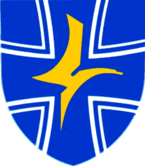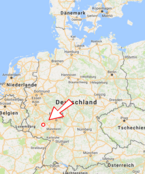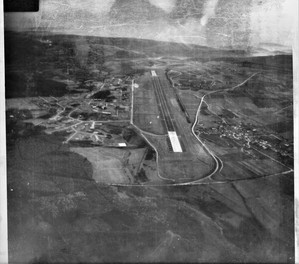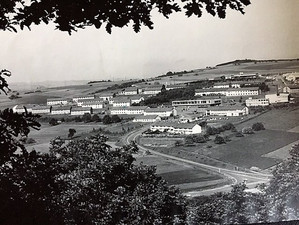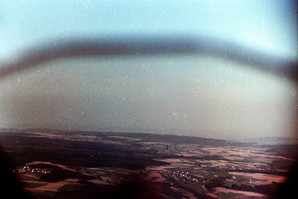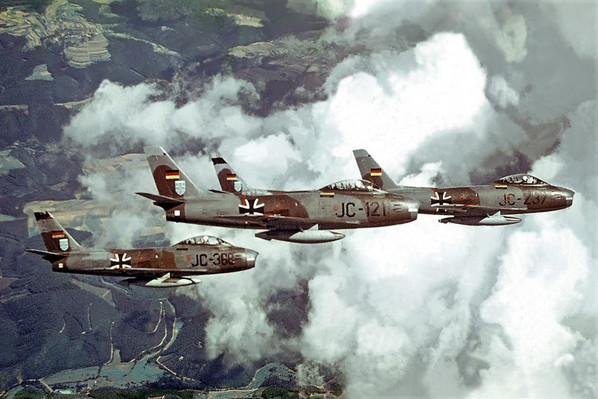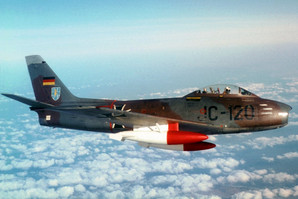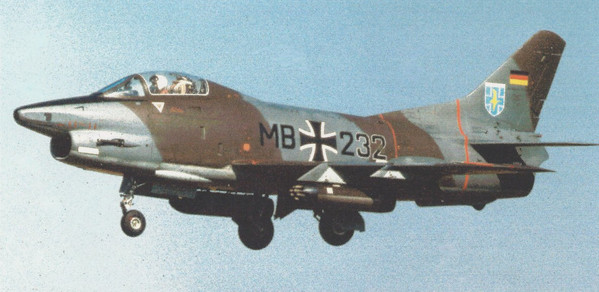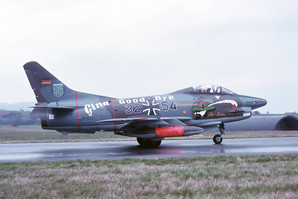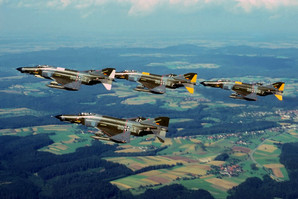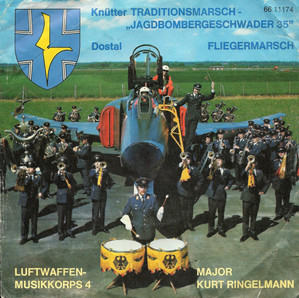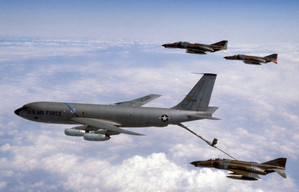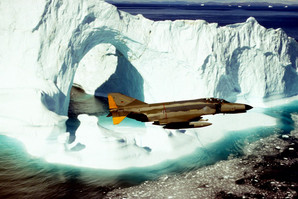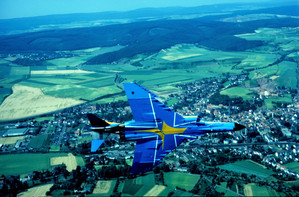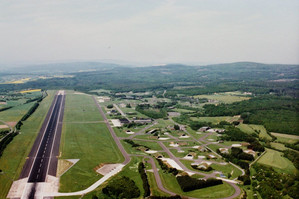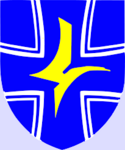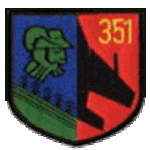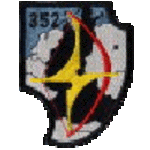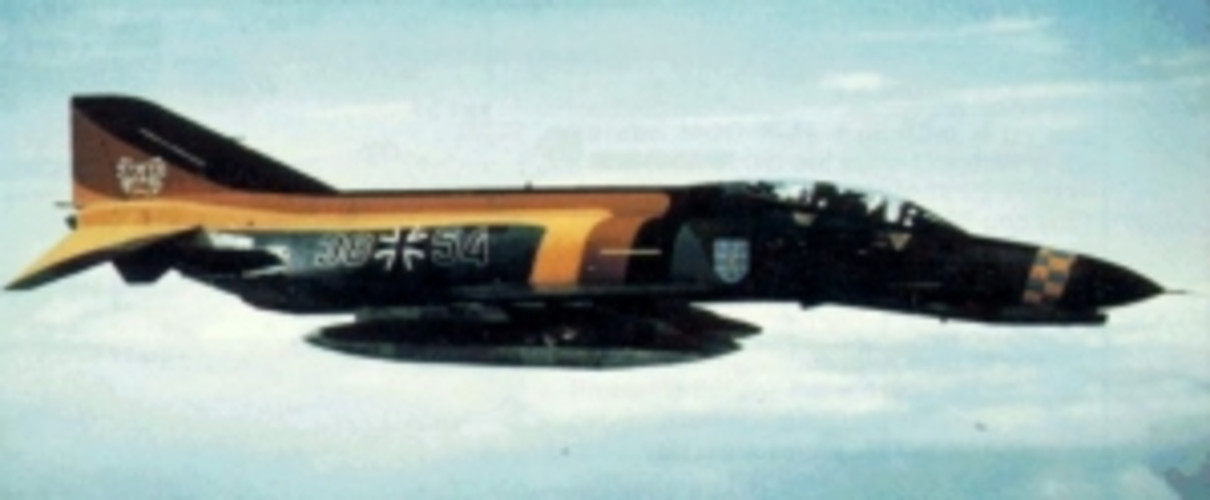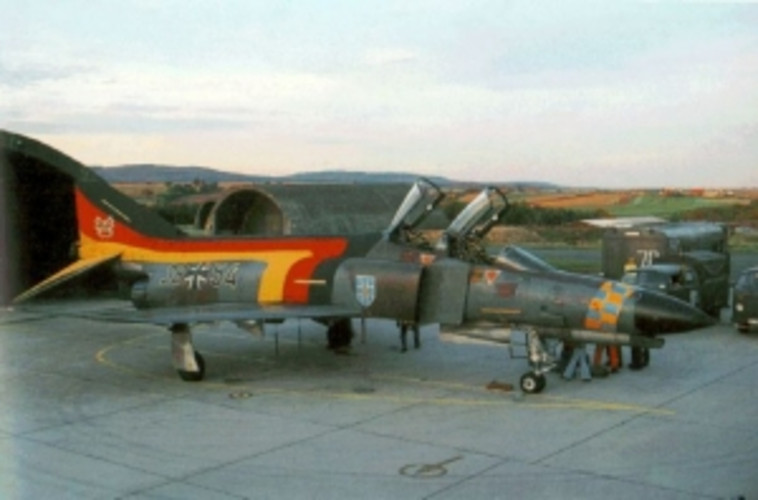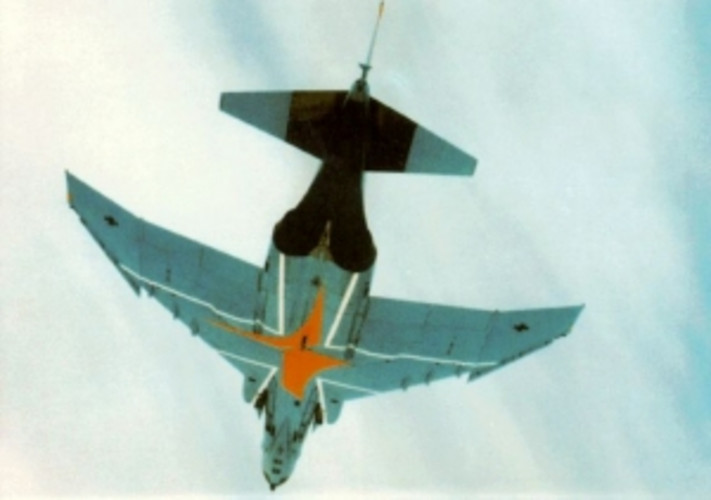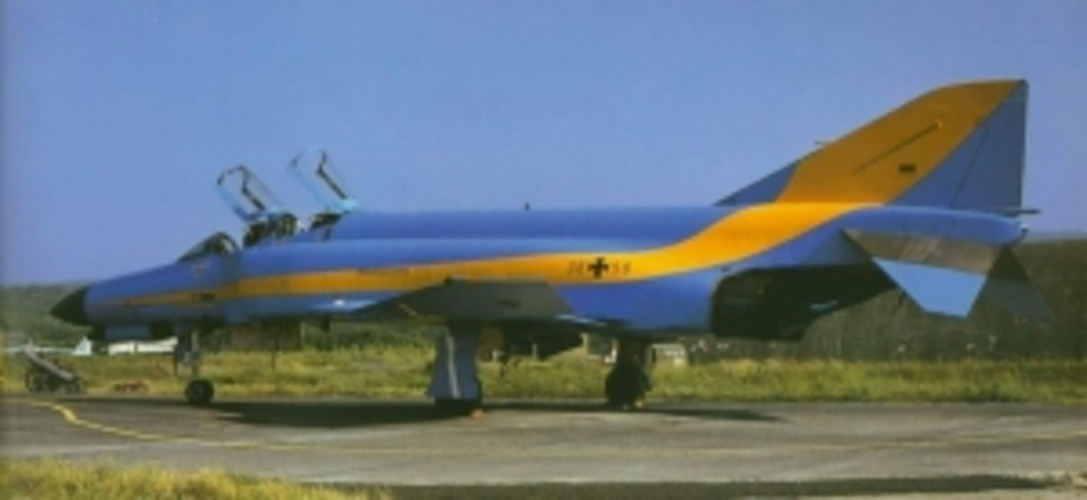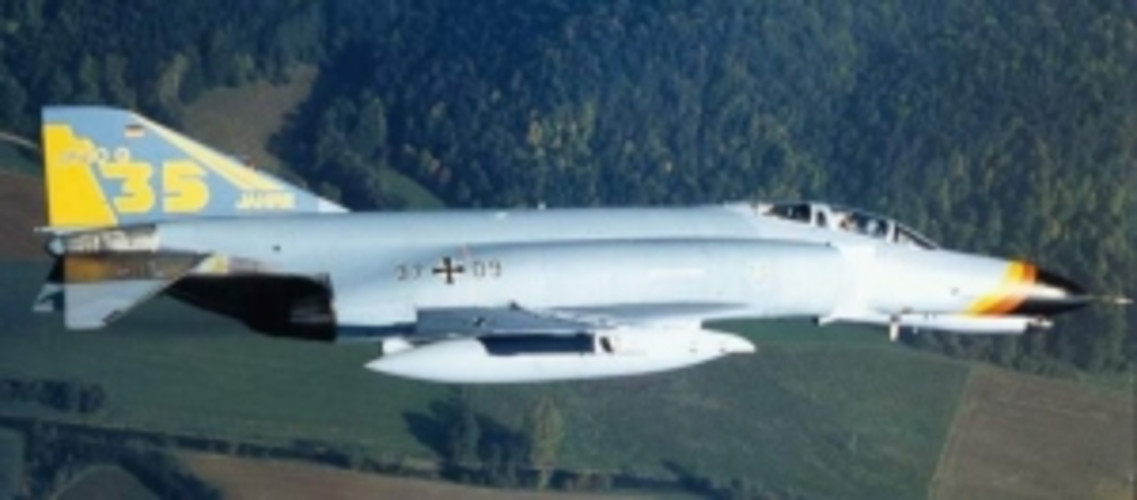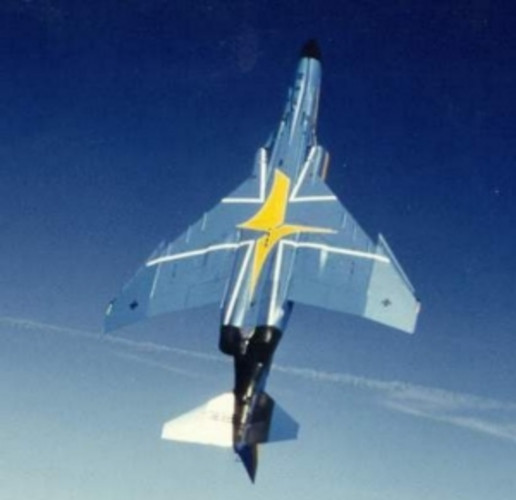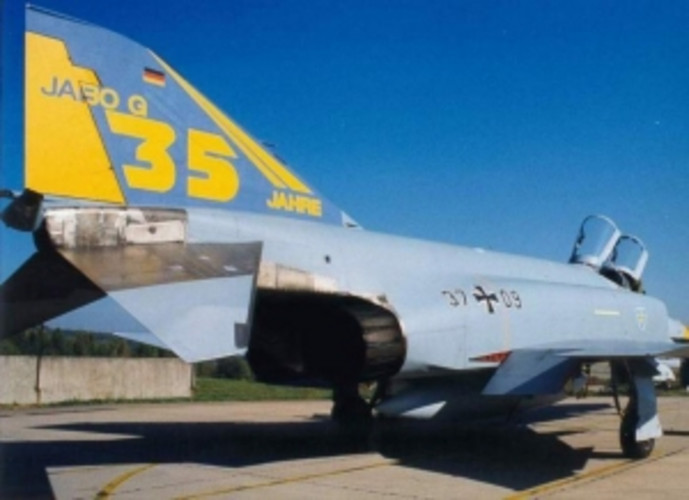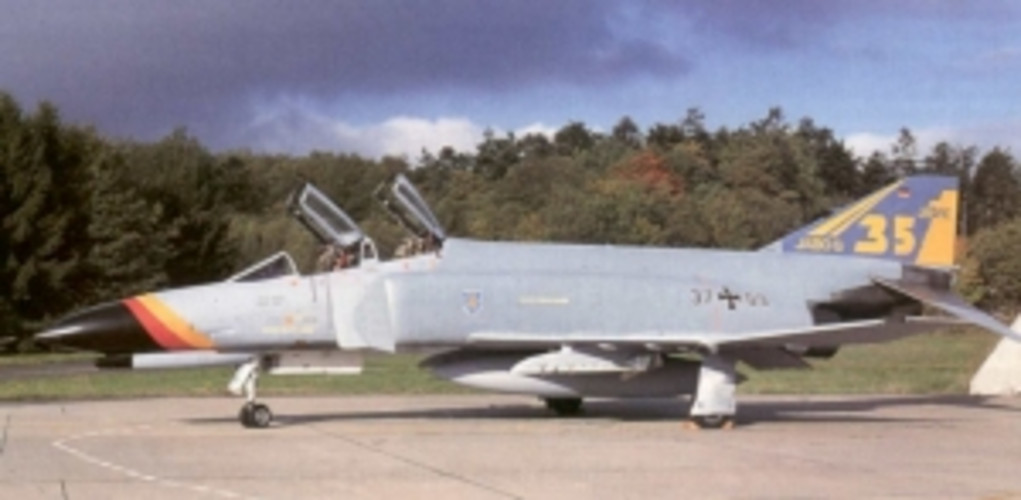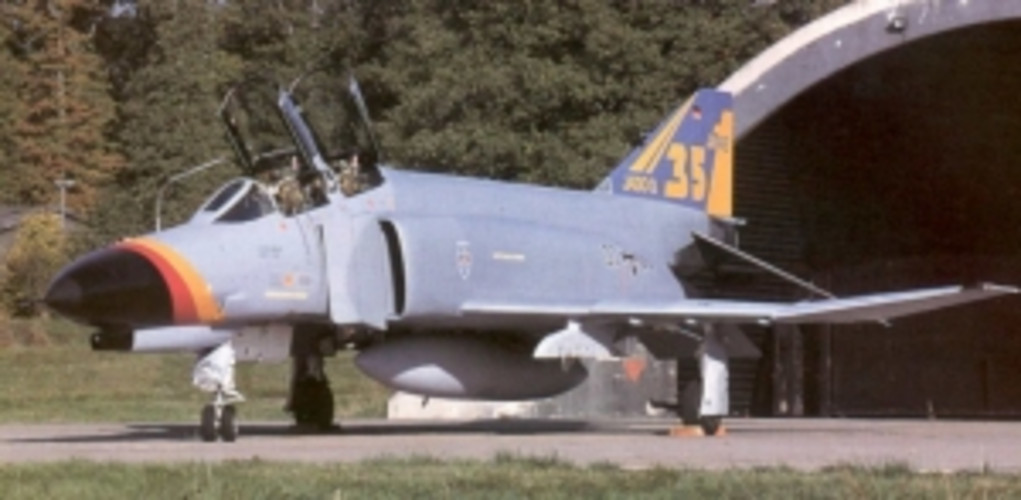FBW 35
Preliminary Note:
This wing differs from other Luftwaffe wings insofar as during its existence at Pferdsfeld (English translation: Horsefield), not only was it given 4 designations, while flying 3 different aircraft, but also, because it was not just dissolved and then disappeared. An F-4 F “Phantom II” component (the 2. Fighter Squadron) together with a MiG-29 Squadron - originally from Preschen Airbase – from 01. October 1994 on constituted Fighter Wing 73 at Laage airbase near Rostock.
Despite all relocations, equipment changes and different designations: The original wing crest (which since 1963 outlasted all changes) is still worn by the Eurofighters of today´s Tactical Luftwaffe Wing 73 „Steinhoff” at Laage.
History of Pferdsfeld airbase
Driving by car from Bingen / Rhein along the Nahe river upriver until Bad Sobernheim and from there northwards toward the Mosel river, through hilly and rising terrain one crosses a large wooded area, the Soonwald. In this remote but beautiful low mountain range, which once was the home of the notorious robber „Schinderhannes “, one would not easily suspect a larger airfield. An airfield of Pferdsfeld´s size is commonly associated with flat terrain. Still, this large airfield for combat aircraft existed here until 1998.
As with so many airbases in Germany, the history of „airbase Pferdsfeld“ began in the middle 1930s, likely in preparation for a coming war. Within the scope of the site investigation an agricultural area within the community bounds of Pferdsfeld, a little village on the southern rim of the Soonwald, was defined as useable, and during the summer of 1938 construction work for the airfield began.
In August 1939 barracks and fuel depots were added and on 1 September 1939 a group of HS-126 short range recce aircraft deployed to the austere airfield. But already in October these redeployed to a more southerly base closer to the border with France. From November 1939 until 22 June 1940, when the battle for France ended, the airbase was used by DO-17 long range recce aircraft. After this unit moved away, Pferdsfeld airbase was no longer used militarily until the end of WW II.
A new beginning after WW II
After the war ended, the French occupation forces found the austere airfield and expeditiously began to develop it into a regular air base with a 2438 x 45 meter runway and the required taxiways, aprons, hangars and fuel / ammunition storage areas. However, the French Air Force never did use the airfield, because in the meantime the allied occupation forces had agreed to divide Germany into 4 occupation zones and so in 1957 ownership of Pferdsfeld airbase was transferred to the US. USAFE had already used Pferdsfeld as a so called „Maneuver Airfield“ since 1952. This transfer of ownership meant additional construction measures like a runway extension to 3000 meter plus overruns and additional housings etc. As the airfield was used only sporadically by USAFE, ownership was again transferred in 1959 to the fledgling German Air Force (Luftwaffe)
In spite of fierce protests by the residents of the villages Pferdsfeld, Eckweiler and Rehbach, which were located directly adjacent to the runway, Luftwaffe leadership decided in 1960 to relocate the on 1 October 1959 in Oldenburg commissioned Jagdgeschwader 73 (Fighter Wing 73) to Pferdsfeld. The small town of Sobernheim, which was located about 10 km to the south in the Nahe valley, became the garrison town. For the Luftwaffe, the advantage was that Pferdsfeld at least areawise was a complete airfield, including runway, taxiways, aprons etc. However, the rest of the infrastructure was found to be in desolate and insufficient condition! Accordingly, almost immediately extensive construction activities began on the airbase, and the barracks were newly built in a scenic location about 2 km north of Sobernheim on the slope of the Nahe river valley.
In many respects, this airfield was problematic because of:
- Noise problems, especially because of the above mentioned three villages.
Rehbach: This little village was located directly adjacent to the eastern overrun of the runway within the approach lighting, and therefore represented a significant safety risk for flying operations as well as for the inhabitants themselves. Towards the end of the 1960s the relocation into the a few kilometers distant “Neu-Rehbach” began and was completed in 1972 with the leveling of the old village.
Pferdsfeld and Eckweiler: Here, the noise problem started when the wing converted from the relatively quiet G-91 (without afterburner) to the noisier F-4 F. In response to a petition by a group of predominantly younger inhabitants of the affected villages an aircraft noise panel was established. This panel concluded that only a relocation of the affected villages would solve the noise problem. The decision was in no small measure influenced by the tireless agitation of a small group of people, to which the author as participant in several meetings of the panel can testify.
Contrary to public opinion and official statements as well, not the Luftwaffe demanded the relocation, but a small group of people, which by the way did not have a positive attitude towards the Luftwaffe!
The decision led to significant confrontations between proponents and opponents of the relocation, as especially the older inhabitants and farmers had found full- and part time jobs on the airbase. However, the once taken decision was not altered. Starting in 1979, the relocated inhabitants found their a new home in a new development area in the eastern section of Sobernheim.
- Topographical problems
Anybody who has taken off or landed on the Perdsfeld runway knows what we talk about here. The runway not only had a significant slope along the longitudinal axis, but also was twisted in the lateral axis, which had negative effects especially in heavy rain or winterly conditions. It was not unusual that pilots unfamiliar with the conditions were irritated enough during approach and landing to produce long landings. The taxiways to the aprons and shelters also had significant slopes, which could cause problems especially in ice and snow.
All in all, compared with all other airbases of the German Air Force and Navy - even Büchel - Pferdsfeld was by no means an ideal place from which to operate combat aircraft.
Jagdbombergeschwader (Fighter Bomber Wing - FBW) 35 and its predecessors at Pferdsfeld
The wing´s history with changing operational missions, designations and aircraft can be divided into four sections:
- F-86 „Sabre“ era - F-86 „Sabre“ / G-91 era - G-91“ Gina“ era - F-4F „Phantom II“ era | Jagdgeschwader (Fighter Wing - FW) 73 Jagdbombergeschwader (FBW) 42 Leichtes Kampfgeschwader (light FBW) 42 Jagdbombergeschwader (FBW) 35 | 61.11.11. – 64.10.01. 64.10.01. – 67.05.01. 67.05.01. – 75.04.01. 75.04.01. – 94.10.01. |
(End of flying operations 1997.07.03.)
Jagdgeschwader (FW) 73 and the F-86 „Sabre“ era
The setup of Jagdgeschwader (FW) 73 as the first predecessor of Jagdbombergeschwader (FBW) 35 began on 01 October 1959 at airbase Ahlhorn, initially with personnel only. Before the first aircraft arrived, Jagdgeschwader (JG) 73 in November 1959 deployed to Waffenschule (Weapons School) 10 at Oldenburg airbase, where it was on 01 December 1959 officially commissioned with Colonel Schröter as first commander. The units’ aircraft received the tactical identification “JC+Numbers”.
On 17 October 1961 the first aircraft landed at their new home base Pferdsfeld. The Luftwaffe commander General Kammhuber officially commissioned JG 73 at Pferdsfeld on 11 November 1961. JG 73 existed for only three years, which were shaped by two location changes, the inadequate infrastructure at the final location Pferdsfeld, and the longlasting construction activities at the airfield as well in the new built barracks.
But despite these problems, flying training and general flight operations were conducted according to plan, with temporary deployments to other airfields. Already in June 1962 JG 73 participated in a competition between Fighter Wings at Westerland airfield on the island of Sylt.
From 1962 on a Quick Reaction Alert (QRA) capability with at the time 5 (!!!) aircraft was implemented, however, during daytime hours only, as the F-86 was not all-weather capable.
But it soon became apparent that the evolving NATO strategy, resulting in the concept of „Flexible Response“, would have consequences for the Luftwaffe: The number of fighter wings was reduced and the number of fighter-bomber wings increased. With subordination under the 5th Luftwaffe Division on 1 July 1963 the fighter role ceased, and with it the requirement for a QRA. This change was extremely unpopular with the „Hunters from Kurpfalz“, as the pilots named themselves after a German traditional song. Amongst them were three WW II aces with a total of 341 kills amongst them. It did not help at all that it was decided to replace the F-86 with the ground attack aircraft G-91. This change was generally felt as degradation and humiliation of the former fighters.
The introduction of the G-91 was planned for September 1963 but had to be postponed due to technical problems with the aircraft. So, the pilots started their training for the fighter bomber mission from February 1963 on with their F-86s. Unfortunately, the F-86 was designed as a high-altitude fighter and not suited for the low-level fighter bomber mission. All three deadly accidents with the F-86 in 1964/65 occurred in conjunction with air to ground missions! The role change was reflected by renaming Jagdgeschwader 73 into Jagdbombergeschwader (JaboG) 42 on 1 October 1964.
The era „F-86 Sabre / G-91“ with Jagdbombergeschwader (FBW) 42
As a result of the delay with introducing the G-91, the training for the fighter bomber role was continued with the F-86 on hand with detachments to air-to-ground ranges at Decimomannu / Sardinia and Westerland on the Island of Sylt, among others.
When in June 1966 the first G-91s arrived the F-86 days were numbered. During the conversion phase the 1. Squadron flew F-86 as well as G-91, whereas the 2. Squadron flew only G-91. Consequently, it became the 1. Squadron pilots’ task to fly the no longer needed F-86s to their new (and mostly final) destinations. Among others, 90 Luftwaffe F-86s were flown to Iran via Italy, Greece, and Turkey. The official farewell ceremony for the F-86 Sabre was held on 12 February 1967. Altogether, 42 000 Hours were flown with this aircraft at Pferdsfeld.
Pilot conversion training for the Fiat G-91 „Gina“ remained up to the end of its use with the Luftwaffe the responsibility of Waffenschule (Weapons School) 50 at Fürstenfeldbruck. On 1 May 1967, the wing was again renamed into „Leichtes Kampfgeschwader 42“(Light Fighter Bomber Wing 42). This also was associated with a thorough restructuring of the unit.
The era of the Fiat G-91 “Gina“ with Leichtes Kampfgeschwader 42 (LeKG 42)
The restructuring measures included the creation of two „Big” Squadrons, which incorporated pilots and maintenance personnel required for operations. Thus, the two squadrons were able to operate independently and could be quickly deployed to airfields further east. This would have been necessary in case of an attack by the Warsaw Pact because range and payload of the G-91 were extremely limited.
The two squadrons roles, and consequently the emphasis for training and daily operations, differed from each other as follows
- the Recce Squadron (1. Squadron) with 70% reconnaissance and 30 % fighter bomber missions
- the Fighter Bomber Squadron (2. Squadron) with a reversed percentage of missions.
The conversion to G-91 started in the spring of 1966, and on 12 June 1966 the first 4 single seat G-91 R 3 for LeKG 42 landed at Pferdsfeld. Due to the role change LeKG 42 on 1 April 1998 was then subordinated to the 1. Luftwaffe Division at Meßstetten.
The first years with the G-91 were characterized by the training of flying and maintenance personnel, as well as deployments required by construction work on the airbase (e.g. Sembach AFB in 1969). In addition, the wing participated in several large exercises like „Schneller Pfeil“ and „Schwarzer Löwe“. The yearly flying program also included participation in NATO-exercises, e.g. the „Tactical Weapons Meet”.
Early 1970 the then commander of the Luftwaffe, Lieutenant General Steinhoff, ordered LeKG 42 to adopt the centralized maintenance organization of the F-104 wings on a trial basis. Based on positive results of this trial, all light fighter bomber wings of the Luftwaffe were accordingly reorganized; however, the mission spectrum was not changed. Only when Reconnaissance Wings 51 and 52 received dedicated RF-4 E recce aircraft in 1971 the reconnaissance mission for the G-91 was terminated.
In June 1971, the parliamentary defense committee decided to procure 175 F-4 F “Phantom II” aircraft for the Luftwaffe. These were intended to replace the F-104 G aircraft of Fighter Wings 71 and 74 as well as those of Fighter Bomber Wing 36. As fourth wing to receive F-4 F eventually LeKG 42 was chosen after a controversial debate withing Luftwaffe high-level decision-making bodies. To implement this, it was decided to dissolve LeKG 44 at Leipheim and to create a “new” wing with the personnel of LeKG 42 and 44 at Pferdsfeld. In 1973 extensive construction work began to get the base infrastructurally ready for the F-4 F, which was a much heavier, complex and capable aircraft than the G-91.
This at first did not affect flight operations with the G-91, which continued without restrictions with deployments, exercises, TacEval and others.
During the era Fiat G-91 “Gina” the wing flew 84 700 Hours, and it should not be left unmentioned that 10 000 Hrs. were also flown with the wing´s T-33 until 1972, when these aircraft were withdrawn from service.
As it was decided to avoid mixed operations - as was the case with the era F-86/G-91 - LeKG 42 was 1 April 1975 renamed „Jagdbombergeschwader (JaboG) 35” (Fighter Bomber Wing (FBW) 35) and G-91 operations ceased. The last G-91 left Pferdsfeld on 14 April 1975, while construction work to make the base ready to start operations with F-4 F until 1 October 1975 continued according to plan. To keep their currency, the pilots were temporarily assigned to LeKG 41 and 43 until their conversion training started.
The era of the F-4F “Phantom II“ with Jagdbombergeschwader 35 (JaboG 35 - FBW 35)
Section 1: the conversion
The designation „Jagdbombergeschwader 35“ (Fighter Bomber Wing 35) was chosen in order to complete the lineup of fighter bomber wings from JaboG 31 to 36, in which JaboG 35 was missing since JaboG 35 at Husum was renamed LeKG 41 when converting from F-84 F to G-91 in 1965.
The conversion of the Pferdsfeld wing to F-4 F was significantly more complex than the conversion of the three F-104 wings and is therefore covered in more detail. It was not just a swap of aircraft, but the change from a flying- and maintenance wise „easy“ single seat light ground attack aircraft to a heavy and in every respect complex weapons system with a two-man crew and the capability to be used in the air-to-ground as well as in the air-to-air role! Even though the decision was still being debated, the Luftwaffe managed to plan and implement all the required personnel changes in a timely manner. Among others, the manpower requirement for maintenance had doubled to 800 compared with the G-91, and with a two man crew the flying squadrons also grew to double their previous size.
On 1 September 1973 Oberst (Colonel) Haarhaus took command from Oberst Eimler, and so it became his task to lead the wing through the difficult conversion phase. Possibly the least pleasant task for him and Oberst Jungkurth, the commander of LeKG 44 at Leipheim, was the formation of the new unit by amalgamating personnel from both wings. Not everybody of the Pferdsfeld wing could stay; some had to be transferred for various reasons. And not everybody from the Leipheim wing wanted to be transferred to Pferdsfeld. On the other hand, not everybody who wanted to move from Leipheim to Pferdsfeld could be considered! This was no easy task for the two wing commanders, as their decisions impacted not only duty aspects, but individual and family fates as well.
One personnel decision proved to be especially beneficial: In the summer of 1974 Oberstleutnant (LtCol) Wienß was given the responsibility to coordinate the whole conversion process („Ede“ Wienß retired as a Brigadegeneral and was the second „squadron commander” of the DPS).
He was well suited for this task because not only was he an exceptionally gifted pilot and instructor, but he also had from October 1971 until May 1974 gained flying expertise on the RF-4 C Phantom as exchange pilot at Shaw AFB before he converted to the F-4 F. The first of many conversion conferences in September 1974 was already led by him.
Flying conversion training of the first six aircrews began in January of 1975 at George AFB, CA with the 20th TFTS. The aircrews consisted out of 3 pilots each from LeKG 42 and 44 as well as 3 weapons system operators (WSO) each from Recce Wings 51 and 52. These six instructor-aircrews were available at the start of flying operations at Pferdsfeld in October 1975. All pilots had to absolve the required flying training course at George AFB, whereas the WSOs came to the wing after their training with Waffenschule 50 at Fürstenfeldbruck. The task of the instructor aircrews (another three were trained in 1976 at George) was to further develop the new F-4 flyers into mission-ready aircrews.
The training of maintenance, repair, and overhaul (MRO) personnel began in the spring of 1975. Initially the complete MRO leadership was trained with TSLW 1 at Kaufbeuren. The electronics technicians also were trained at Kaufbeuren, whereas to facilitate fast and cost-effective training for the remainder of personnel, a technical training detachment (TAI) was established at Pferdsfeld airbase. Thus, all required training was completed by the time the last F-4 F arrived in June of 1976.
The first wing-owned F-4 F arrived on 7 July 1975 from Wittmund airbase and was immediately after landing made available to the TAI for training purposes. The first „official“ Phantom was flown in again from Wittmund on 25 September 1975 by the wing commander Oberst Haarhaus and the project officer Oberstleutnant Wienß . This aircraft still carried the crest of JG 71 „Richthofen“ and the writing „foreign aid from Ostfriesland“, together with a couple of cows painted on it! The last pilot conversion course at George AFB ended on 19 March 1976, and the full complement of aircraft was reached when the wings last F-4 F arrived on 21 June 1976: It was the very last production aircraft with the identifier 38+75.
After the first detachment to Decimomannu airbase with air-to-ground and air-to-air weapons qualification was completed in autumn 1976, the conversion of JaboG 35 was inofficially considered as completed.
The smooth conversion and re-training were recognized on 3 February 1977 by the commander 1. Luftwaffendivision with the “Prinz-Heinrich”-award. At the same time, command of JaboG 35 was transferred from Oberst Haarhaus to Oberst Pacholke, his previous deputy. It fell to him to lead JaboG 35 through a national evaluation and then through the first NATO evaluation: Both were successful in February and May of 1977. The final report by the TAC EVAL Team dated 13 May 1977 marks the successful conversion and reintegration of JaboG 35 into NATO.
To conclude the conversion section, it can be stated that despite all doubts this was achieved within the same timeframe as with the F-104 wings converting to F-4 F. This was only made possible through excellent planning, high motivation, and exemplary cooperation on all levels.
Section 2: Flying operations
Flying operations until the wing was decommissioned on 1 October 1994 followed the usual pattern. The yearly tactical training program (TCTP) for the „Tactical Fighter“ role included - besides routine flying operations at Pferdsfeld - yearly detachments to Decimomannu / Sardinia or Beja /Portugal for weapons qualification and from 1981 on to Goose Bay /Labrador for extreme low level training. In addition to various NATO exercises, every year aircrews and maintenance personnel participated in various courses like TLP and competitions, e.g. TAM, weapons loading and cross servicing competitions. Regular squadron exchanges with other NATO air forces were also an interesting part of flying operations. Due to construction work on the base, several deployments to other bases (e.g. Hahn AFB) were required as well.
Frequent „Family Days“ and „Open Houses“ served to present the wing and its people to the public; these events always attracted thousands of guests.
It would be too much to cover all the personnel changes, but some highlights of various nature deserve mentioning. These should be considered as mere selection without any claims concerning completeness or importance!
- June 1975: Sponsorship agreement with the 8th Infantry Division, US Army, Bad Kreuznach
- June 1977: Premiere of the „Jagdbombergeschwader 35 heritage march“ at a big military concert. Thus, JaboG 35 became the first and only Luftwaffe wing to have its own march!
- February 1978: Again, the wing received the „Prinz Heinrich“ award by the commander 1. Luftwaffe division, and the Luftwaffe flight safety award as well.
- June 1978: The wing was awarded the „Vulcan Trophy“ during the „Tactical Air Meet“ at RAF Wildenrath.
- July 1978: Inaugural visit of Verteidigungsminister (SecDef) Apel with the Luftwaffe, represented by JaboG 35.
- July 1978: An aircrew and associated maintenance crew represented the Luftwaffe at Rhein-Main Airbase Frankfurt on the occasion of the President of the United States’ visit to Germany
- March 1979: Foundation of the JaboG 35 choir.
- October 1979: JaboG 35 20th birthday celebration with roll call and hangar party.
- March 1980: As a result of the „Tactical Fighter“ concept JaboG 35 has to man a QRA again.
- July 1981: SecDef Apel on his second visit used the wing as showcase for the visit of the leader of Japan´s Self-Defense Administration.
- September 1981: First detachment to Goose Bay, Canada. On the return trip, the distance of 2750 Nautical Miles was covered in 6:15 Hours with air refueling.
- July 1983: The wing reached 250 000 total hours.
- April 1984: Pferdsfeld ATC guided the 200 000. radar approach (GCA) and the „Martin Baker“ section conducted the 1500. ejection seat inspection.
- March 1985: Once again, the wing received the „Prinz Heinrich“ award by the commander 1. Luftwaffe division, and with it the Luftwaffe flight safety award.
- July 1985: until August 1988: Several aerial demonstrations by a JaboG 35 demo team, first with 4, then with 6 aircraft. It was dissolved after the catastrophic accident at Ramstein.
- August 1991: The Ministry of Defense announces that relocation of either JaboG 36 or 35 to Laage airbase in former East Germany is under evaluation.
- August 30, 1993: The Ministry of Defense announced, that JaboG 35 would be merged with the MiG-29 trial wing from Preschen. Both units together would form a new fighter wing Jagdgeschwader 73 (JG 73) at Laage airbase near Rostock.
- June 1993: The last Dornier Do-28 was retired.
- August 1993: 300 000 flight hours total were reached.
- November 1993: Again, the wing received the „Prinz Heinrich“ award.
- June 01, 1994: The 2. Fighter Bomber Squadron was decomissioned.
- June 06, 1994: 150 000 flight hours F-4 F were reached.
Section 3: The End
As JaboG 35 in a way lived on at Laage and several actions interlocked with each other, it is not easy to describe the final days of JaboG 35. Therefore, only the events at Pferdsfeld airbase are covered here.
On 1 October 1994 Jagdbombergeschwader 35 Pferdsfeld was dissolved and integrated into Jagdgeschwader 73 under the designation „Fighter Wing 73, section F-4 F“. Despite this being a somber occasion for Pferdsfeld, at the same time a positive event also was celebrated: the wing’s 35th birthday. Following a military tattoo on 30 September 1994 in Sobernheim, on the next day a big hangar party with 15 000 visitors was organized.
In July 1996, the QRA was deactivated. Up until June 1997 flying operations with the remaining assets took place at Pferdsfeld. The personnel reduction had already started December 1994 on all levels.
The definite goodbye came on 3 July 1997: With a military ceremony and in the presence of many guests, the commander of the Luftwaffe, Lieutenant General Mende, officially deactivated Pferdsfeld. Subsequently, the doors were opened for the public a last time and the day concluded with a big hangar party. The highlight of the evening reduced almost everybody to tears: After night fell, all the airfield lights were illuminated and then section after section shut down. In the following darkness, the runway was illuminated by a firework, which resembled the wings crest in shape and color, accompanied by the well-known song “Time to say Goodbye” by Andrea Bocelli
An indeed very emotional and dignified Goodbye!
Epilogue:
On 7 July 1997, after almost 36 years of operations with various aircraft types, the last 3 F-4 F “Phantom II” took off from Pferdsfeld. Altogether 310 000 Hours were flown, of which more than half were with the Phantom.
During these years, 8 aircrew members lost their lives:
3 Pilots with the F-86
2 Pilots with a P-149D liaison aircraft
1 Pilot with the G-91
1 Pilot / 1 WSO with the F-4F
In March 1998, the base and barracks were handed over to the Federal Property Administration: Jagdbombergeschwader 35 with its predecessors at Perdsfeld were history for good!



